CONSTELLATION GUIDE
Last updated: 20 June 2001
CONSTELLATION GUIDE |
"GO TO"....AQUARIUS
....water, water, everywhere and not a drop is real....
From: sherrodc@ipa.net (Clay Sherrod)
This is the eighteenth Constellation Guide, "GO TO AQUARIUS" of the series "GO TO GUIDES for the ETX and LX 90 Telescope Users". Unlike our previous "GO TO" guide, Capricorn, this constellation features MANY wonderful deep sky objects, interesting stars and much wonderful historical interest. Yet Aquarius is a notably "ignored" constellation by the amateur astronomer, even those in extreme southern latitudes. I have always attributed this fact to the lack of bright "showcase" stars and at least one outstanding "trophy" object." Lyra has the "Ring Nebula", Andromeda has its galaxy, Taurus the Crab Nebula and the Pleiades, even lowly Vulpecula boasts the likes of "the Dumbbell Nebula."
If I ask you to name one outstanding deep sky object in Aquarius....can you do it? Likely not. Aquarius is located VERY low in the Summer northern skies, yet is perfectly placed for southern hemisphere and very low latitude northern hemisphere observers; as the sky chart shows, the ECLIPTIC - the band in which the sun, moon and planets all appear to move within - runs through this very large constellation, yet all objects within its boundaries will be both NORTH (positive "+" declinations) and SOUTH (negative "-" declinations) of the Celestial Equator which runs right through the northern regions of this large constellation.
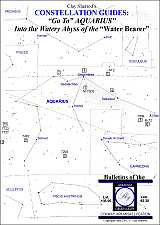
Aquarius is just ONE of seven constellations in this region that has some association with "water," and reveals the fascination of water subjects (perhaps due to arid conditions of the "original" Arabian namers of the stars?) to the earliest stargazers. In addition to the "aquatic" Water Bearer of Aquarius, we have: CETUS (a whale), PISCIS AUSTRINUS (southern fish), CAPRICORN (the "seat goat"), PISCES (a fish), DELPHINUS (the dolphin), and ERIDANUS (a celestial river). The importance of seafaring to the earliest people and the need for good navigational targets such as stars provide close to the southern horizons, likely gave rise to this "watery association."
In Greek legend it is from Aquarius, the "bearer of water" that the crow "Corvus" (west of Aquarius) was supposed to have stopped on its journey to apprise the gods of the losing battle against strong and perhaps immortal enemies to the west; but stopping to drink the water of Aquarius rather than telling the Gods of the ill-fated warriors' plight, the battle was lost by the refreshing detour chosen by the bird. Hence, for disobeying his orders and allowing the defeat of the Greek warriors, he is now eternally destined to fly at his given position of the sky with parched mouth, a dry rock in his beak and far from any refreshing relief from the Water Bearer.
Although the star field of Aquarius if far richer than that of Capricorn (http://www.weasner.com/etx/ref_guides/capricorn.html ) this area of our late summer skies is still fairly void of conspicuous star patterns that are memorable to the stargazer. It, for lack of better words, is a destination not often frequented by amateur astronomers. Nonetheless, there ARE some interesting objects in Aquarius that we will explore on this "GO TO" TOUR.
There are MANY galaxies in the realm of the Water Bearer, but most of these NGC objects are too faint for our telescopes and, indeed, many are beyond the reach visually of even very the largest telescopes except photographically. Hence, these galaxies (and some other faint objects of other types) are not discussed in this guide. Throughout our "GO TO" guides, only objects that are within reach of telescopes ranging from 60mm to 200mm aperture are typically discussed; occasionally you will find noted an important object or "position" that is of historical or other interest that CANNOT be seen in our telescopes.
As with all "GO TO" TOUR guide star charts, please click on this accompanying chart above to open; you can save this to file, resize to paper size and print for a nice usable desk reference or good field chart as you proceed through the Aquarius "GO TO" TOUR.
Also with every "GO TO" TOUR guide, each GO TO object in Aquarius is discussed for your telescope regarding the type of conditions necessary for you to view it optimally for discern the very faintest details.........magnifications and aperture necessary for most objects, and much, much more. This is YOUR complete GUIDE to get you on your way to exploring the best (and few!) objects in these two constellations. The following listing of "BEST" objects contains the finest or most interesting from my own observing experience and preference.
Use the attached star chart and the following Guide as an excellent reference for your next star party itinerary, or a beginning for further study into the thousands of objects visible in this part of the sky. Truly these extensive Constellation Study Guides will most definitely put your AutoStar to work for you in the most efficient and enjoyable way possible! As a matter of fact, MANY AutoStar users are now programming their own "Tours" based on these guides, using each constellation as a separate GO TO Tour for the AutoStar library that can be added in or deleted through the main edit screen on your PC or MAC computer.
We hope you enjoy these comprehensive GUIDES to touring the constellations via your AutoStar and its computer-driven telescope. Each new installment is complete with diagrams, charts and illustrations that you will find nowhere else. Please let us hear YOUR feedback and your observations of each and every constellation after YOU have toured its vast reaches of our skies!
-----------------------------------
YOUR AQUARIUS CONCISE DIRECTORY OF INTERESTING OBJECTS -
Take time to familiarize yourself with the large constellation of Aquarius and its borders. Within this constellation, even though it may seem uninteresting from the "un-interesting wrappings" of its star-poor outline, there are many fascinating deep sky objects, the best of which are discussed here. Also there are MANY doubles stars and some of the nicest and most interesting variable stars of all. One of my favorite "cataclysmic" and unpredictable variables - AE AQUARII - is located here and affords a wonderfully bright erratic star that can change in the course of hours to observers using small and medium telescopes. That star is also detailed in this guide.
I have chosen the finest (or most interesting) 12 objects in this AQUARIUS "GO TO" TOUR; as with all GUIDES, all objects listed below will be visible in most telescopes (some naked eye) from the ETX 60 through the LX 90; of course larger apertures may "show" an object a bit closer and "better," but frequently a wide field and low power view is more desirable than aperture for FINDING the objects initially. Indeed, I strongly encourage you first FIND the target object, or its approximate location through your GO TO function with your lowest power and then - once IDENTIFIED positively - move up slowly in steps with magnification if necessary. Remember, not all objects "like" magnification. Sometimes better "field of view" (such as the wonderful wide fields provided by the ETX 60 and 70) is desired over light gathering (like the big LX 90) and magnification.
The rule for determining "optimum magnification" is that: 1) too low power results in sky background glow detracting or diminishing the contrast against the deep sky object; 2) too high magnification darkens BOTH the sky background AND the object; 3) medium magnification can be achieved at which you have MAXIMUM contrast between the object and its darkened background sky. I have found through three decades of direct observing that about 15x per inch aperture (36x for the ETX 60/70; 55x for the ETX 90; 75x for the ETX 125; and, 125x for the LX 90).for deep sky observing is PERFECT for most objects. That being said, always remember that DOUBLE or multiple stars require whatever power you can crank out....the seeing conditions are the limiting factor here.
For my complete and comprehensive discussion regarding seeing conditions and sky transparency, see: http://www.weasner.com/etx/buyer-newuser-tips/seeing.html .
With all deep sky objects, avoid attempting to observe when the moon is in the sky, even a very thin crescent, as its brightness in the sky will overshadow the very dim contrast afforded by even the brightest deep sky object; if you see the object at all against moonlight, you will NOT see the subtle outlying areas or the full detail of what is presented.
Aquarius is conveniently placed in late summer skies and lends itself well to very good and long-period observing for ETX and LX 90 users both north and south of the equator. I rises in the east about dark (9 p.m. local time) on about August 1 and "culminates " (passes over the meridian at midnight) around August 25, remaining in the sky throughout that night, transiting the meridian just before midnight. All deep sky objects and difficult double stars are ALWAYS best observed when they are located nearly overhead (or as high in the sky as possible), thus requiring the observer to look through the thinnest portion of the Earth's "lens" of atmosphere and haze.
As with all of the "GO TO" TOUR constellation lists, I recommend a good star atlas and/or chart which will list all the finest objects, constellation-by-constellation. One very handy reference guide is the PETERSON FIELD GUIDE TO THE STARS AND PLANETS, which features complete lists with declinations, right ascensions, magnitudes, and all pertinent information for you to expand your observing horizons beyond this brief GUIDE.
Note that your AutoStar will NOT have every object listed on every constellation GO TO tour....this is intentional. You can access some of the most interesting objects of the sky directly from their coordinates. It is quite simple as you merely enter these coordinates as follows in the 10-step process:
1) Press the "MODE" key and hold down for 3 seconds and release;
2) Displayed will be the current Right Ascension and Declination of the center of field of view of where your telescope is presently pointed (assuming that you have properly aligned from "home position");
3) [NOTE: if you have the Meade electric focuser attached to any of the ETX or LX telescopes, holding down the "MODE" key will bring up the "Focus" command first....merely scroll (lower right scroll key) down one step to access the RA and DEC to enter your desired coordinates]
4) Press the "GO TO" button on AutoStar;
5) This will change the display and you will note the cursor blinking over the first digit of RIGHT ASCENSION (R.A.); merely use the number keys and dial in the R.A. of the object you are searching for;
6) When done, press "Enter;"
7) This moves the blinking cursor over the "DEC" coordinates;
8) [NOTE: the declination, unlike R.A., can be either positive or negative and you will see the "+" or "-" sign displayed depending on where your telescope is aimed at that time; if it is NOT the desired setting (plus or minus), merely use your arrow key to move the blinking cursor OVER the "+" or "-" sign and change by using either of your lower corner SCROLL KEYS;
9) Proceed to enter the DEC using number keys;
10) Press either "Enter" or "Go To" when finished and the telescope begins slewing to your desired object!!
The constellation tour Star Chart above (click on and save to a file on your PC; then open it and re-size to fit the page and print for a very handy at-the-scope star chart) will get you started on your journey for this constellation.
Following is the concise object list for your "GO TO" TOUR of AQUARIUS; you may wish to find the majority of the objects from the AutoStar Library (for example, you can easily go to the globular cluster Messier 2 if you pull up "Object/Deep Sky/Messier/..then type in '02'...." and then press "Enter", followed by "GO TO" to access this remote globular cluster. On the other hand, if you want to experiment and become a "better AutoStar user" try entering the exact R.A. and DEC coordinates of that object as described above after holding down the MODE key. You will find the accuracy of entered GO TO's to be somewhat less than those stored in AutoStar, but the capability of acquiring unlisted objects is fantastic!
OBJECT 1:
brighter star - SADALMELEK (alpha Aquarii) - R.A. 22h 03' / DEC (-) 00 34 - Magnitude: 3.2
OBJECT 2:
good double star - Zeta Aquarii - R.A. 22h 26' / DEC (-) 00 17 - Mag. 3.7, good star for ETX 90 and up
OBJECT 3:
nice variable star - R Aquarii - R.A. 23h 41' / DEC (-) 15 34 - Mag. range = 5.8 to 11.5 - erratic, nice!
OBJECT 4:
wonderful variable - AE Aquarii - R.A. 20h 38' / DEC (-) 01 03 - A very rapid irregular variable, nice object
OBJECT 5:
very concentrated globular - Messier 2 (ngc7089) - R.A. 21h 31' / DEC (-) 01 04 - Mag: 6.3 - Super!
OBJECT 6:
faint globular - Messier 72 (ngc6981) - R.A. 20h 51' / DEC (-) 12 44 - Mag: 9.8, small & unresolvable
OBJECT 7:
a Messier MISTAKE! - Messier 73 (ngc6994) - R.A. 20h 56' / DEC (-) 12 51 - Did Messier goof up??
OBJECT 8:
"Saturn Nebula" - ngc7009 - R.A. 21h 01' / DEC (-) 11 34 - Mag: 8.4, very interesting in larger scopes
OBJECT 9:
"Helix Nebula" - ngc7293 - R.A. 22h 27' / DEC (-) 21 06 - Mag: 6.5 - very larger - ideal scope is ETX 70!
OBJECTs 10:
two close galaxies - ngc7727 & ngc7723 - R.A. 23h 36' / DEC (-) 13 14 - Mags: 11.1 & 10.7, nice
OBJECT 11:
faint globular - ngc7492 - R.A. 23h 06' / DEC (-) 15 54 - Mag: 10.8, very faint, star-like in small scopes
---------------------------------
A VISUAL GUIDE TO OUR DEEP SKY OBJECTS IN AQUARIUS
Object 1 - Our "Starting" Brighter Star - "SADAL MELEK" (alpha Aquarii)
This giant star may be up to 80 times larger than our own sun, but at a distance of 1100 light years, it appears only as a 3rd (2.92) magnitude star. It has the same spectral identity as the sun ("G"), but is huge by comparison, and over 6,000 times brighter if placed at the same distance! The wide-field view surrounding this star is a pretty sight on a very dark night, particularly with the wide field of view afforded by the ETX 60 and 70.
Object 2 - Zeta Aquarri - A Wonderful Double Star for the ETX 90
This is a wonderful double star for the ETX 90 as a test object, only about 1.6" arc separating its two components. It should be a relatively easy object in the ETX 125 and LX 90, with the brighter component being magnitude 4.4 and the secondary only slightly more dim at magnitude 4.6. The two orbit one-another every 600 years or so and the closest the seem to get (right about now!) is the current separation that we witness. Since the theoretical resolution limit of the ETX 90 is 1.3" arc, it should easily resolve this double with pretty high magnification (around 200x) and steady air. Currently look for the two stars in a nearly north-south orientation to one-another, a perfect alignment for a perfect test in small telescopes!
Zeta is the central star in the familiar asterism known as the "Water Jar" of Aquarius, a Y-shaped pattern formed by Gamma, Zeta, Pi and Eta in this constellation as shown in the chart below.
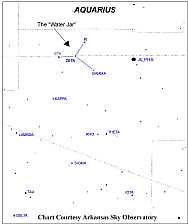
Object 3 - A Great Variable Star - R Aquarii
There is no wasted time when observing this wonderful and erratic variable star! There is so much to this complex star that an entire evening could be spent observing and contemplating the nature of this curious object. R Aquarii is a huge Red Giant pulsating variable star which likely went "nova" about 600 to 700 years ago and expelled a huge cloud of gas and dust, a shell that can be photographed, but not seen as attested in the wonderful photo below from the 100" Lick Observatory reflector.
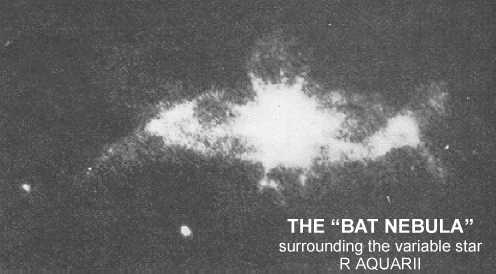
Coined the "bat nebula" from its characteristic shape, this is a rapidly-expanding cloud of gas that was ejected during the star's explosion. At present, the star is classified as a "semi-regular" star because it exhibits a rough "period" of about 386 days during which it might brighten to magnitude 6.0 or thereabouts. The light curve shown following demonstrates that this star is ANYTHING but predictable, and that it is known for long periods of time in which rapid and minor fluctuations around magnitudes 8 and 9 occur.
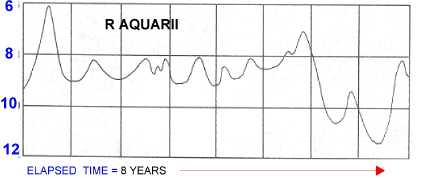
To locate and monitor this wonderful variable star - suitable for long-period observing with the ETX 60 and all telescopes larger - you merely log onto the web site of the American Association of Variable Star Observers (AAVSO) for valuable observing information and locator/comparison charts. As has been frequently mentioned in these "GO TO" TOURS, a variety of charts is always available for nearly every variable star known. For these charts, the AAVSO has selected very constant and stable comparison stars with exact magnitudes provided with which the variable can be compared. The "a" scale charts are naked-eye locator charts for brighter stars that required brighter comparison stars across the sky; "b" is slightly smaller scale with fainter stars; "c" is telescopic at medium magnification with stars typically visible in the ETX 90 and larger scopes, while the "d" charts reach as faint as magnitude 14 and below.
For R Aquarii, access the chart http://charts.aavso.org/AQR/R_AQR/RAQR-A.GIF , save it to file, open and resize to print for the "a" finder chart that will get you started. Since R Aquarii rarely gets too faint, for comparison purposes the chart http://charts.aavso.org/AQR/R_AQR/RAQR-B.GIF will serve for all telescopes as an ideal source for good comparison stars for the curious cycle of this star.
Object 4 - AE Aquarii - A Fantastic Variable for Our Telescopes
Using the same source, you can access the star charts for AE Aquarii, another wonderful and very unpredictable "cataclysmic variable" star in Aquarius. Locate the star first using the "a" chart
http://charts.aavso.org/AQR/T_AQR/TAQR-A.GIF and then move up to the very detailed and fainter limiting magnitude chart "d" at http://charts.aavso.org/AQR/AE_AQR/AEAQR-D.GIF to make your comparisons as AE Aquarii takes you through its roller-coaster fluctuations on a minute-by-minute basis. In 1982 I was involved in a major study of cataclysmic variable stars such as this one; it required monitoring 32 stars, each at a 30-minute interval over an entire night! In the case of AE Aquarii, visual changes in this star amounting to 0.3 magnitude could be seen in a period of only hours, creating a feeling of true change in the Universe!
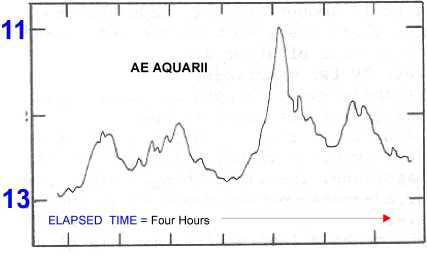
There is CONSTANT change going on with this star....it will "sit" idle for a period of time, followed by sudden and explosive changes in brightness that can actually double the magnitude of this star! Very rapid changes that can be detected through our telescopes can be seen in less than one hour! Normally the flare-ups that characterize this interesting star will be followed by a somewhat slower (but still fairly fast) decline in brightness, only to have another follow in just a few days....like a "recurring 'mini-nova' ." At a typical 9th or 10th magnitude this star is easily followed in the ETX 90 and larger scopes. In actuality, it is a binary star of which the two components are LIKELY separated in space with LESS DISTANCE that there is between the Earth and its Moon! That is fantastically close for two stars. Thus, the outbursts are thought to be result of very volatile gases being "pulled" from a cooler star to a very HOT star adjacent to it, at which time the "new" gases add fuel to the fires and result in flare-ups.....much like squirting lighter fluid on your already-burning charcoal grill.
Object 5 - A Great Globular Cluster - Messier 2 - (It's been a while since we've seen a good one here!)
Finally! A Messier Deep Sky Object that we don't have to squint to see! Messier 2 is oddly located nearly one-half the way around the sky from Messier 1. Go figure! At any length, this is a very nice globular cluster, although not on the same scale as the famous Messier 13 in Hercules, or those in Ophiuchus. For a complete observing guide to globular clusters, see my description at:
Messier 2, at magnitude 6.3 will appear distinctly as something "other than a star" in the ETX 60 and 70 and gets better with increased aperture; even at the very lowest power and widest fields, this is a nice object, appearing as a faint round glow in all instruments; increased magnification in the larger instruments will begin to show many delicate stars along the outer edges. This cluster, unlike Messier 3 and Messier 13 is very compact and concentrated; it is only about 7' arc across visually, compared to 11' for Messier 13. This is one of those deep sky objects where a bit of increased magnification will assist in a better view; I recommend using about 20x per inch for ideal viewing. Although over 100,000 stars populate this globular its vast distance of over 50,000 light years - much farther than M-13 - makes for difficult resolution. This huge object would be spectacular if placed at the same distance as Messier 13.
Object 6 - Another Globular Cluster.....Messier 72 - Not quite so pretty as Messier 2!
You might want to keep Messier 2 handy for comparison with Messier 72, another globular cluster in Aquarius. Just 3 degrees NE of M-72 is another object on our TOUR, the "Saturn Nebula", ngc 7009. Although the visual magnitude of M-72 is 9.1, bright enough to be a relatively easy object in the ETX 90, its size makes for a difficult object, at only 4' in diameter. This will appear as a very fuzzy star in the smaller instruments. The LX 90, with powers up to around 300x, can begin to see some indications of stars around the outer edges of this small, compact and very round cluster. Nonetheless, it is a good object for all telescopes, noting that you can brag that this is "....one of the most difficult globular clusters of any to resolve" in amateur telescopes, and is an incredible 60,000 light years away, far more distant that even Messier 2, discussed above. Incredibly, there have been over 45 variable stars actually discovered and monitored within this very distant object!
Object 7 - The Messier Object that "Isn't" - Messier 73
Either Charles Messier actually DID see a comet in October of 1780 when he logged this position of his 73rd "faint fuzzy" (he was, after all, making a list of all objects that MIGHT be confused for faint, non-tailed comets!), or he was suffering a setback after attempting to resolve stars in his 72nd object, discussed above. For at this position - which you really need to take a look at - there is NOTHING! Four stars, magnitudes 10.5 (two of those), 11.0 and 12.0 all together. Keep in mind that his small telescope likely might not have been able to detect the fainter star, so the mysterious nature of WHY he cataloged an object here is even more compounded. Messier recorded "3 or 4 stars" here, but in addition noted that there was nebulosity associated with those stars.....had he, indeed, seen a COMET superimposed OVER those distant stars? It is entirely possible and if so, he likely was the only living person to have ever seen that one, for it was never verified and there is no way to determine if it was seen before or after his sighting of whatever occupied the space now known as "Messier 73!"
Object 8 - THE SATURN NEBULA - NGC 7009
This is a very unusual planetary nebula, not at all appearing nor physically matching the "typical" planetary nebula like the Ring Nebula (M-57, see: http://www.weasner.com/etx/ref_guides/lyra.html ) or the large "Helix Nebula" discussed here for Aquarius (below).
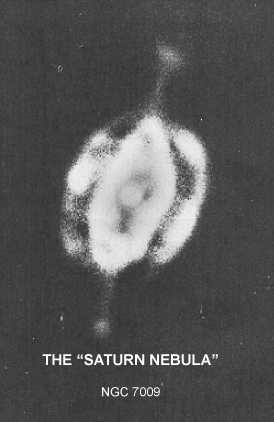
The "Saturn Nebula" is so-named because of its two gaseous arm-like extensions (or "ansae") which project nearly north-south from the center of the gas cloud. This nebula is small (44" x 26", about the size of Jupiter's disk) and bright (8.4 magnitude, easy enough to see in the ETX 60/70 with about 60x +), so it is a good object for all telescopes. Medium, to medium-high magnifications are recommended for best views. In the ETX 125 and LX 90 this is an OUTSTANDING object, rivaled in mystique only by "the ghost of Jupiter" (see your Autostar: "Object / Deep Sky / Named....."). There is a distinct greenish or blue-green color to ngc7009 that almost looks falsely-lit in the telescope! In the LX 90 the ansae can be clearly seen with about 225x, and on very, very dark nights in the ETX 125 as well; in smaller telescopes, only the brighter central planetary nebula shell is visible. This is actually a fairly close planetary nebula to Earth, at only 3900 light years distant. The magnitude 11.7 central star which created the Saturn Nebula may be glimpsed on very dark nights at about 150x with the ETX 90 and certainly with the ETX 125 and LX 90 telescopes.
Object 9 - Another Wonderful Planetary Nebula - The Very Large "Helix Nebula"
The largest such object of its kind, the "Helix Nebula, ngc7293, is nearly half the size of the lunar disk - about 16' arc across! It has a total brightness (if all of its spacious size was compressed into the size of a star's disk) of 6.5, making it a very bright object. However, because that brightness is spread over such a large area, it is best seen in very low power, wide field views. Hence, the ETX 60 and 70 are ideal instruments for observing this beautiful "ring" of stellar gases. In larger telescopes, be sure to use your lowest magnification and widest field of view possible. This object can clearly be seen as a small round glow in good 7 x 50 or 10 x 50 binoculars. Although not appearing as bright, the Helix Nebula appears very much visually (and photographically) as the famous Ring Nebula in Lyra, as attested in the 200-inch Palomar photograph below:
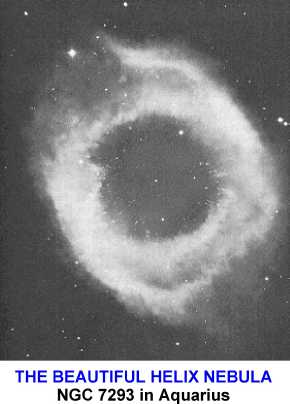
In addition to being the brightest and largest of its type, ngc7293 is also maybe the CLOSEST to Earth, at only 85 light years! As a matter of fact the close star which "nova-ed" to produce the shell is still visible in perhaps even the ETX 125 as a very central 12.5 magnitude star. This star is clearly visible in my LX 90.
Objects 10 - Two "Companion Galaxies": ngc 7723 and ngc7727
These are two galaxies that are within the same low power, wide field of view, even in the ETX 90. At magnitudes 11.1 and 10.7, respectively this pair is often overlooked when some attention is really deserved of the two. Use very low power to find and view them together, separated only by about 45' arc. Both are spiral galaxies with no discernable features in any of the telescopes, but beautiful nonetheless within a fairly rich field of faint stars. ngc 7723 measures a small 2.2' x 1.6' arc oval while ngc7727 is nearly round and about 3' arc across. With the LX 90, you MIGHT be able to sometimes glimpse two delicate and faint "arms" extending up to 5' arc from the central region of this galaxy. Do not expect to see either of these faint galaxies in the ETX 60 and 70.
Object 11 - Our Final Object - the faint globular cluster ngc7492
Sometimes given as magnitude 10.8 and others a much fainter "12.3", this globular is easy enough that I tend to agree with the former estimate. Either way, it certainly is NO M-2. It is larger however, than Messier 72 in Aquarius, at a diameter of nearly 3.5' arc, still nearly three times smaller than Messier 2. At this small size, it is NOT visible in the ETX 60, 70 or 90, but can be detected looking like a faint nebulous star in the ETX 125 and perhaps a bit better in the LX 90. This globular is nearly twice the distance from Earth as Messier 2, hence its small size and faint apparent magnitude.
--------------------------------
WANDERING ABOUT....YOUR NEW "USER OBJECT" IN AQUARIUS
How can I resist....was there EVER any doubt that astronomers make mistakes? (....or is there any doubt that we don't ALWAYS make mistakes?). If you believe in cosmic perfection, then believe that there is, indeed, nebulosity at position R.A. 20h 56.2m, DEC -12 degrees 51m, the position of Messier's 73rd object. You can impress your friends and neighbors with the fact that they are seeing something that Messier did NOT see: nothing. It is really a very interesting conversation point....Did Messier, over two centuries ago, actually discover a COMET at this position and NOT KNOW IT? It is entirely possible, and you can show everyone where it actually happened (or should that be "didn't happen?"). This missing Messier object should definitely be part of your USER OBJECT library!
On AutoStar, go to: "Select/Object [enter]...." scroll down to "User Object" [ enter]. Now enter the coordinates given above for "Messier 73", using the number keys on AutoStar. After entering the coordinates and pressing "Enter" yet again, scroll down one and you can list the magnitude of the object as "0"[Enter].
So with the addition of the "missing Messier object" (there are actually "two" - the other has been found, thank you) you are completing a set which includes a black hole, dark nebulae, curious multiple stars, variable stars and weird deep sky objects. All of these are wonderful for conversation-starters and crowd-stoppers at the big astronomical events!
Next Constellation GO TO" TOUR Installment: PEGASUS, the might "winged steed of the heavens." This constellation gives hints of the wondrous impending fall constellations and the nearby constellation of Andromeda with its famous galaxy! In Pegasus you will explore the "great square" (no....we are NOT referring to the heavenly spirit of Lawrence Welk) and the many fascinating objects that rest within its borders.
Good Observing and explorations of this wonderful world of deep space!
P. Clay Sherrod
Arkansas Sky Observatory
Conway / Petit Jean Mountain
Arkansas
Return to the top of this page.
Go back to the Observational Guides & References page.
Go back to my ETX Home Page.